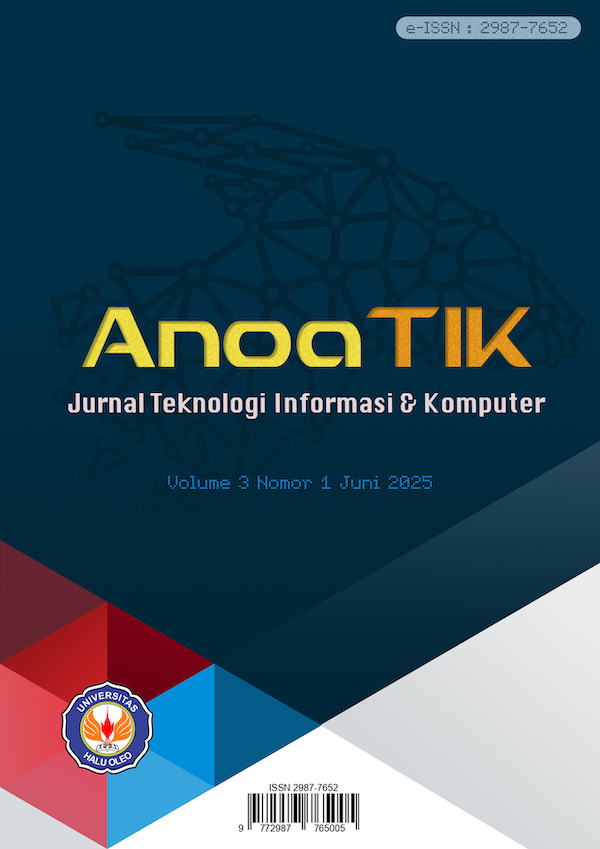ARSITEKTUR BISNIS PERUSAHAAN OTOBIS
DOI:
https://doi.org/10.33772/anoatik.v3i1.85Abstrak
Transportasi umum memegang peranan penting dalam mendukung mobilitas dan aktivitas ekonomi di berbagai wilayah. Perusahaan otobus, sebagai komponen utama transportasi umum, menghadapi tantangan besar di era kemajuan teknologi dan perubahan preferensi konsumen. Penelitian ini bertujuan untuk merancang arsitektur bisnis terintegrasi bagi perusahaan otobus dengan menggunakan kerangka Business Model Canvas (BMC) yang didukung modul-modul Enterprise Resource Planning (ERP). Melalui pendekatan deskriptif-kualitatif, modul ERP utama seperti Sales and Distribution, Production Planning, Materials Management, Financial Accounting, dan Human Capital Management dipetakan ke elemen-elemen BMC. Hasil penelitian menunjukkan bahwa integrasi modul ERP ke dalam kerangka BMC meningkatkan efisiensi operasional, pengendalian biaya, dan pengelolaan hubungan pelanggan. Penelitian ini menyimpulkan bahwa penerapan arsitektur bisnis berbasis ERP memungkinkan perusahaan otobus meningkatkan daya saing, adaptasi terhadap dinamika pasar, serta mendukung tujuan keberlanjutan.
Unduhan
Referensi
A. Aloui, N. Hamani, R. Derrouiche, and L. Delahoche, “Systematic literature review on collaborative sustainable transportation: overview, analysis and perspectives,” Transp. Res. Interdiscip. Perspect., vol. 9, no. January, p. 100291, 2021, doi: 10.1016/j.trip.2020.100291.
T. Campisi, S. Basbas, A. Skoufas, N. Akgün, D. Ticali, and G. Tesoriere, “The impact of covid-19 pandemic on the resilience of sustainable mobility in sicily,” Sustain., vol. 12, no. 21, pp. 1–25, 2020, doi: 10.3390/su12218829.
R. C. Shelton, M. M. Philbin, and S. Ramanadhan, “Qualitative Research Methods in Chronic Disease: Introduction and Opportunities to Promote Health Equity,” Annu. Rev. Public Health, vol. 43, pp. 37–57, 2022, doi: 10.1146/annurev-publhealth-012420-105104.
G. Georgiadis and G. Poels, Enterprise architecture management as a solution for addressing general data protection regulation requirements in a big data context: a systematic mapping study, vol. 19, no. 1. Springer Berlin Heidelberg, 2021. doi: 10.1007/s10257-020-00500-5.
G. Oeschger, P. Carroll, and B. Caulfield, “Micromobility and public transport integration: The current state of knowledge,” Transp. Res. Part D Transp. Environ., vol. 89, no. November, 2020, doi: 10.1016/j.trd.2020.102628.
K. Lepenioti, A. Bousdekis, D. Apostolou, and G. Mentzas, “Prescriptive analytics: Literature review and research challenges,” Int. J. Inf. Manage., vol. 50, no. April 2019, pp. 57–70, 2020, doi: 10.1016/j.ijinfomgt.2019.04.003.
A. Aloui, N. Hamani, R. Derrouiche, and L. Delahoche, “Systematic literature review on collaborative sustainable transportation: overview, analysis and perspectives,” Transp. Res. Interdiscip. Perspect., vol. 9, no. January, p. 100291, 2021, doi: 10.1016/j.trip.2020.100291.
K. Irina, Z. Victor, P. Halyna, V. Liudmyla, and N. Halyna, “Corporate Architecture of Sustainable Development Reporting as a Tool Market Capitalization of Agrarian Business of Ukrainian Companies,” Rev. Econ. Financ., vol. 21, no. 1, pp. 393–404, 2023, doi: 10.55365/1923.x2023.21.40.
M. K. Alam, “A systematic qualitative case study: questions, data collection, NVivo analysis and saturation,” Qual. Res. Organ. Manag. An Int. J., vol. 16, no. 1, pp. 1–31, 2021, doi: 10.1108/QROM-09-2019-1825.
A. O. Salonen and N. Haavisto, “Towards autonomous transportation. Passengers’ experiences, perceptions and feelings in a driverless shuttle bus in Finland,” Sustain., vol. 11, no. 3, 2019, doi: 10.3390/su11030588.
R. G. G. Caiado, L. F. Scavarda, B. D. Azevedo, D. L. de M. Nascimento, and O. L. G. Quelhas, “Challenges and Benefits of Sustainable Industry 4.0 for Operations and Supply Chain Management—A Framework Headed toward the 2030 Agenda,” Sustain., vol. 14, no. 2, 2022, doi: 10.3390/su14020830.
[12] I. W. E. Arsawan, V. Koval, I. Rajiani, N. W. Rustiarini, W. G. Supartha, and N. P. S. Suryantini, “Leveraging knowledge sharing and innovation culture into SMEs sustainable competitive advantage,” Int. J. Product. Perform. Manag., vol. 71, no. 2, pp. 405–428, 2022, doi: 10.1108/IJPPM-04-2020-0192.
S. Tiwari, P. Sharma, T. M. Choi, and A. Lim, “Blockchain and third-party logistics for global supply chain operations: Stakeholders’ perspectives and decision roadmap,” Transp. Res. Part E Logist. Transp. Rev., vol. 170, no. October 2022, p. 103012, 2023, doi: 10.1016/j.tre.2022.103012.
O. Dziubaniuk and M. Nyholm, “Constructivist approach in teaching sustainability and business ethics: a case study,” Int. J. Sustain. High. Educ., vol. 22, no. 1, pp. 177–197, 2021, doi: 10.1108/IJSHE-02-2020-0081.
Unduhan
Diterbitkan
Cara Mengutip
Terbitan
Bagian
Lisensi
Hak Cipta (c) 2025 intan nurhidayah, Isma Izha Utama, Muhammad Ainul Yaqin

Artikel ini berlisensiCreative Commons Attribution-ShareAlike 4.0 International License.











